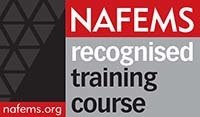FEAkn2 | Define the meaning of degree of freedom. |
FEAco1 | Describe the sources of error inherent in finite element analysis, in general terms. |
FEAco2 | Discuss checks that may be used post-solution to check for the presence of inaccuracy. |
FEAco6 | Discuss the need for a consistent set of units in any analysis and illustrate possible pitfalls. |
FEAco29 | Discuss the term flying structure or insufficiently constrained structure. |
FEAco35 | Discuss the terms Validation and Verification and highlight their importance. |
FEAap1 | Employ an analysis system for the determination of stresses and strains in small displacement, linear elastic problems. |
FEAap2 | Demonstrate effective use of available results presentation facilities. |
FEAap3 | Illustrate the approximate nature of finite element analysis, through examples chosen from your industry sector. |
FEAap10 | Illustrate various physical situations which will result in a Stress Singularity and explain why it is not appropriate to use finite element results at such locations directly. |
FEAap12 | Employ a range of post-solution checks to determine the integrity of FEA results. |
FEAan1 | Analyse the results from small displacement, linear static analyses and determine whether they satisfy inherent assumptions. |
FEAan2 | Compare the results from small displacement, linear elastic analyses with allowable values and comment on findings. |
FEAsy1 | Prepare an analysis specification, including modelling strategy, highlighting any assumptions relating to geometry, loads, boundary conditions and material properties. |



